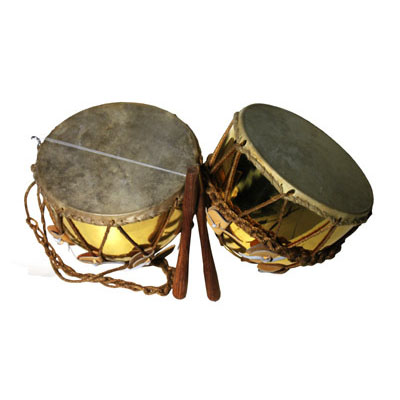nagela overview
 Nagra (pinyin: Nà gélā) was called Nagara and Nugula in the historical records of the Qing Dynasty. Because the drum body is made of iron, the Han people call it iron drum, and it is also known as Dongba. Popular in Xinjiang Uygur Autonomous Region.
Nagra (pinyin: Nà gélā) was called Nagara and Nugula in the historical records of the Qing Dynasty. Because the drum body is made of iron, the Han people call it iron drum, and it is also known as Dongba. Popular in Xinjiang Uygur Autonomous Region.A small medieval timpani pair of drums originating in Arabia (classified as membranous in the Hornposter and Saxophone system). Found in North Africa, Turkey, Syria and Iraq at the end of the 20th century, this instrument has a bowl-like body made of wood, metal or earthenware, and its open top is covered with animal leather. In the West it is common to use thicker leather, which is set on the model before the leather is dry. Although Naqara was introduced to Spain by the Moors before the 8th century.
The drum body is cast iron (also made of copper, the drum cavity is hollow, and the drum surface is covered. Two drums of different sizes and pitches are often used to form a pair, which is played by one person. Nagra has no fixed pitch (usually two drums sound) The height differs by about four or five degrees). It is notated with a staves (the larger one is recorded on the third line, and the smaller drum is recorded on the fourth line). Nagra strikes with two drumsticks. Can play singles and doubles Or roll, you can also use the drum center strike, middle ring strike, outer ring strike, drum gang strike, smouldering and other playing methods to obtain the change of the timbre. The two drums can be played alternately or simultaneously. The sound of Nagra is sonorous, often with Suona and Dongba (big iron drum) are played together in ensemble, and can also be used with hand drums for instrumental ensemble or singing and dancing accompaniment.
The ancient Nagra is in the new era, and it entered the hall of modern society from the small corner of the folk. The grand opening ceremony of the Urumqi Economic and Trade Conference for several consecutive sessions, the Nagra drum phalanx lined up in a row, is particularly eye-catching. The scene was not spectacular, but when the drums overlapped and the drums sounded, like the majestic roar of the mountains and the sea, in an instant, the hearts of the people were shocked, the audience was boiling, and the guests at home and abroad were amazed and became the "uncrowned king". nice scenery. At this moment, Nagra is no longer simply a tool to create festive scenes, but has released the function of advertising media that promotes self-inspiration and seduces customers. Unwilling to be left behind in the Western Regions of China, the broad aspirations to revive the glory of the Silk Road.
Since then, many manufacturers and merchants in Xinjiang have invited the Nagra Band to cheer on the drums for their opening ceremonies or commodity exhibitions. Nagra has become an "open weapon" for merchant promotions. Sometimes several shopping malls open at the same time in the urban area. People follow the sound, and the goods sell out fast. Several drummers played one after another, adding vitality to the city. It's no surprise that the drummers paid to be hired are very hardworking and do their own thing. It's just that their drumming skills became more and more unrestrained, all of them were sweating, and they didn't rest. Whose drum beats beautifully, whose business must be "splendid" and "splendid"!
Nagra is like "an ancient earthenware bowl filled with modern delicacies", extending the purely folk entertainment function into the economic field, even the creator of the drum did not expect it. It is not important to explore whether the Nagra drum function is better or worse, the important thing is that its owner still loves it and loves it in every possible way.
- Pinyin:Nà gélā
- alias:Nagala, Nuqula
- origin:arab islamic country
- popular area:Xinjiang Uygur Autonomous Region
overview of other similar instruments
- sanyanxiao overview
- Daguangxian overview
- Leiqin overview
- hahao overview
- yandundagu overview
- Han Xiaozheng overview
- Fang Xiang overview
- guanzi overview
- zhuqin (Dao Qin) overview
- zhuiqin overview
- bangzi overview
- three-stringed piano overview
- Gehu overview
- xiao overview
- xiaokonghou overview
- Konghou overview
- Sheng overview
- suona overview
- hulusi overview
- gushao overview
 渝公网安备 50010702504639号
渝公网安备 50010702504639号